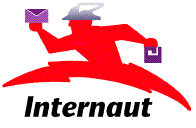
As with so many other milestones in the history of global networks, the porting of the Internet Protocols (TCP/IP) to the PC began as the effort of energetic youngsters. John Romkey, then an undergraduate at MIT, was looking for a part-time job, and encountered an ad placed by Dave Clark. Other students also answered the call, and out of this work came PC-IP, and later the commercial firm, FTP Software, Inc.
Since then, TCP/IP has been installed on thousands of PC-compatible computers worldwide. How many exactly, we do not know, but it would be safe to say that a sizeable fraction of the Internets two million hosts are microcomputers, and that the fraction is growing. The majority of these machines find use as clients, aiding their users in mining the treasures of the net, but seldomly providing services themselves.
Until recently, PC server software has been difficult to write due to the lack of PC operating systems offering pre-emptive multitasking and network support. OS/2 and Windows NT, both including pre-emptive multitasking and TCP/IP support, promise a new level of functionality for Internet-connected PCs. The new found power of the Internet PC will no doubt prove an inspiration to another generation of energetic youngsters.
There is something magical about putting powerful technology into the hands of the curious (and smart), and no networking technology is as magical as TCP/IP. TCP/IP is flexible; with it you can connect computers a few feet away over coaxial cable, or machines thousands of miles away over radio waves. TCP/IP is approachable; hobbyists familiar with other networking technologies, such as the UUCP or FidoNet store and forward protocols, will find within TCP/IP many familiar concepts. TCP/IP software is inexpensive; there is no better way to learn about TCP/IP than to work with it, and there is no easier way to work with it than to use the publicly distributable packages described in this book.
If I am doing my job adequately, this book will help you get over Internet Anxiety and onto the network. There you can fish for Internet info-flounders (or spare tires), voice your opinions on issues of the day, or just hang out. If I have done my job well, this book will be pique your curiousity, and will encourage you to share your knowledge with other people. If I have done my job *really* well, then you will find yourself interested not only in getting connected, but in joining the volunteer corps of moderators, archive managers, and Frequently Asked Questions (FAQ) posting maintainers that makes the Internet what it is. If you want to send me to author heaven, then you will not only get involved in some or all of the above, but will also pitch in by connecting other people.
What is so important about getting people onto the network? In this age of media conglomerates, we need your voice and energy. A person connected is one less person to be cowed by promises of pie in that information highway in the sky.
While conventional media delivers viewers to advertisers, global coputer networks deliver participants to each other. So while a future of 500 cable channels may mesmerize industry executives, regulators, and perhaps even a few average folks, all the reruns in the universe cannot match the worth of one answered question, cry or prayer.
Those who know me, know that I am a passionate advocate for grass roots telecomputing. While we do not yet have many hobbyist users of TCP/IP, the rapid growth in Internet-connected bulletin boards and ToasterNets (Internet connectivity cooperatives) is evidence that the Grass Roots IP movement is beginning to catch on. With any luck, within a few years we will have ToasterNets in every major city, hundreds or even thousands of Internet bulletin boards, and millions of educated enthusiasts.
The major barrier to the spread of the Grass Roots IP movement has been the lack of practical information on use of TCP/IP on the PC. The goal of this book is to break the logjam by putting together in one book all the information you need to connect one or more PCs to the Internet.
I began this journey assuming that PCs could play only modest roles on the Internet, acting primarily as clients. Compiling the listings of TCP/IP applications in Appendix B turned my thinking around. Not only were there DOS and WIndows client implementations for virtually every application, but the depth of the available server applications was stunning.
With the recent addition of many advanced capabilities, the DOS-based server known as KA9Q has become an Internet swiss army knife. If you want to do something on the Internet, the chances are that someone has added that capability to KA9Q, or is in the process of doing so.
With the release of TCP/IP for OS/2 and Windows NTs built-in TCP/IP support, virtually every server application, including sendmail and BIND, is now either available or in the process of being ported to these powerful operating systems. Given NTs affordable pricing and support for lightweight threads and symmetric multiprocessing, NT-based servers now frequently offer performance superior to comparably priced UNIX systems. As a result, the future of TCP/IP on the PC appears bright indeed.
I have written this book, as I write all my books, for the network traveller on a budget. This might seem like somewhat of a contradiction, since direct Internet connections have until recently been notoriously expensive.
However, the situation is changing rapidly. Within the last month we have seen the birth of several services offering flat-rate direct connections for as little as $30/month. By next year, these services will have proliferated, and the direct connections are too expensive and noone can afford to put a BBS on the Internet raps will have passed into memory.
At this point, the grass roots IP movement will begin to gather steam. Then watch out!







